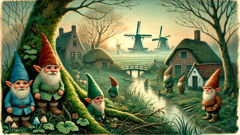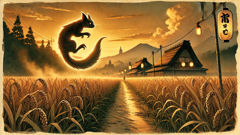Introduction
In the gentle embrace of the Dutch lowlands, where fog rolls like a silken shroud across emerald fields and canals mirror the changing sky, tales grow as tall as the centuries-old oaks that line the dikes. There’s a legend whispered along cobbled lanes, retold as families gather near peat-fueled hearths—about the Kabouter, a mysterious race of tiny folk, neither quite man nor beast, who live in hidden realms beneath the earth or within the very walls of ancient homes. To some, they’re only myth: clever stories for children, spun to explain vanishing tools or loaves of bread that seemed to multiply overnight. But for those who keep their eyes open and hearts patient, the Kabouter are as real as the windmills spinning in the mist. These gnomes—no taller than a rabbit, wearing pointed red caps and beards like spun silver—are famed for their industriousness, their wisdom, and their secret pact with humankind. From the deepest root cellars to the oldest forests, they’ve been the unseen hands behind bountiful harvests, the midnight menders of broken wheels, and the gentle guardians of sleeping children. Yet their help is never demanded—only quietly, humbly accepted. For to win the trust of a Kabouter is a rare honor, and to lose it is to court misfortune. In the village of Veldwoud, nestled on the edge of a sprawling wood, this truth is at the very heart of an old tale: one of curiosity, courage, and a friendship that shaped the fate of an entire village. It begins with a boy named Bram, whose hunger for understanding would lead him to the world beneath his feet—and to the living legend of the Kabouter.
Bram and the Whispering Woods
The spring of Bram’s twelfth year arrived draped in emerald—fresh leaves shimmering in rain-washed sunlight, tulips igniting the meadows with their flaming colors, and every corner of Veldwoud humming with the promise of renewal. Bram was a miller’s son, slight and quick-eyed, known for his restless feet and insatiable curiosity. His mother, Mina, often found him in odd places: beneath the wooden bridge, poking at tadpoles; scaling the old willow by the dike; or lost in reverie beside the garden’s mossy stones. Yet it was the forest bordering the village—the Whispering Woods—that drew him most.
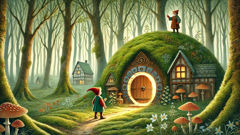
From a young age, Bram heard tales of things that moved when no one watched: mysterious footprints in the mud, glimmers of light at the roots of ancient trees, and laughter that floated just beyond hearing. The elders called them Kabouter—gnomes with faces wrinkled as walnut shells and hands as clever as crows. They were never seen unless they wished, and they helped only those who respected the old ways: a bowl of cream left by the hearth, a kind word for small creatures, a heart that didn’t mock what it could not see.
One morning, after a storm had scrubbed the world clean, Bram slipped away before sunrise. The woods were thick with birdsong and the tang of wet earth. He wandered until the village roofs were swallowed by the green, pausing to study a peculiar trail: tiny footprints—each no bigger than a hazelnut—pressed deep into the loam. Beside them, a feathered cap snagged on a bramble glowed scarlet in the pale light. Bram’s heart thudded. Surely, he thought, this was a sign. He followed, careful not to crush the prints or disturb the delicate mushrooms that clustered nearby.
After what felt like hours, the trail led him to a clearing encircled by ancient oaks. At its heart stood a mound carpeted in moss and star-flowers. Bram crouched low, his breath shallow. A faint humming rose from beneath the earth—a song without words, weaving through the roots and stones. Then, as if conjured by his longing, a door appeared in the side of the mound: round, wooden, with a tiny brass knob. It swung open, and out stepped a Kabouter no taller than Bram’s boot.
The gnome’s beard was snowy white; his cheeks were ruddy as autumn apples. He wore a coat of leaf-green felt and a hat so red it outshone the tulips. His eyes, shrewd and sparkling, met Bram’s with neither fear nor surprise. For a long moment, neither spoke. Then the Kabouter gave a polite nod, as if greeting an expected guest. Bram’s tongue stuck to his teeth. He bowed awkwardly, remembering his mother’s stories: "Kabouters are proud. Never mock, never ask too much, and always thank them."
"Good morning," Bram managed. "I—I hope I’m not intruding."
The Kabouter’s mouth quirked in amusement. "Few humans find this place. Fewer still remember their manners. You may call me Luit," he said, his voice as crisp as frost on the meadow.
Thus began a friendship both secret and wondrous. Luit introduced Bram to a world beneath the forest: tunnels glowing with phosphorescent moss, tiny workshops where Kabouters shaped acorn cups and carved wooden spoons, granaries filled with seeds and root vegetables. The gnomes’ society was orderly and wise; every task had purpose, every hand contributed. In exchange for glimpses into their lives, Bram told stories of the village above—of harvest festivals, church bells, and the taste of summer honey.
Luit explained the pact between Kabouters and humans: the gnomes would mend what was broken, aid lost travelers, and bless the fields—so long as villagers respected the land, honored small kindnesses, and never sought to steal Kabouter secrets. "Our wisdom is rooted in patience," Luit said. "All things have their season."
Weeks passed. Bram visited often, always careful to bring a gift—an apple, a spool of thread, a new song. He learned the subtle ways of gratitude: how to leave cream for thirsty mice, how to patch a torn fence without complaint. Yet curiosity gnawed at him. What other secrets did the Kabouters keep? And why, some nights, did Luit’s eyes darken with worry when he gazed toward the village lights?
One evening, as a thunderstorm brewed and shadows twisted among the oaks, Bram found the answer. He stumbled upon Luit and several elders gathered around a tiny map, their brows furrowed. "Something is coming," Luit whispered, voice heavy with dread. "A danger from beneath—one that threatens both our worlds."
The Threat from Below
The threat that haunted the Kabouters was no ordinary trouble. In the ancient layers of earth beneath Veldwoud, where roots tangled like the fingers of sleeping giants and time itself seemed to flow slower, something old had awakened—a colony of voracious root-worms, known in gnome lore as the Graafslang. These creatures gnawed through soil and stone, undermining not only the gnomes’ subterranean halls but the very foundations of the village above. Signs of their arrival had multiplied: crops yellowing overnight, sudden sinkholes yawning in fields, a strange tremor in the ground during quiet evenings.
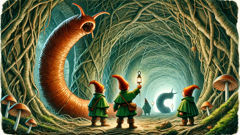
Bram listened as Luit explained the danger. The Kabouters had fought the Graafslang once before, generations past, sealing them deep with spells and clever traps. But the seals were weakening—broken by careless digging, forgotten rituals, and the slow erosion of respect for the old ways. If left unchecked, the worms would devour the roots of every tree, collapse the Kabouter tunnels, and bring ruin to Veldwoud’s homes and harvests.
"We are few," Luit said gravely. "We need help, Bram. But our presence must remain secret. If people learn too much, fear or greed could turn them against us. Will you aid us without betraying our trust?"
Bram nodded without hesitation. He thought of his family’s mill, the laughter of his friends, the scent of warm bread drifting through the village square. All these were linked to the earth—and to the silent labor of the Kabouters. "I’ll do whatever I can," he promised.
For the next several days, Bram divided his time between the world above and below. With Luit’s guidance, he studied the patterns of dying crops and mapped the softening ground. At night, he slipped into the woods to meet the gnomes, learning from their ancient wisdom: how to track vibrations, how to mix garlic and ash into a powder that repelled the worms, how to craft tiny clay charms that strengthened roots. Sometimes he caught glimpses of other Kabouters—children at play in mushroom circles, artisans at their workbenches—but they always regarded him with cautious curiosity, never speaking unless Luit introduced him.
Disguising his efforts as ordinary chores, Bram began quietly reinforcing fences and encouraging villagers to leave offerings by their hearths once more. He spread tales—half in jest, half in hope—of the old ways returning fortune to those who remembered them. Some laughed, but others listened. The baker’s wife resumed leaving crusts on her windowsill for the birds; the blacksmith mended a broken horseshoe and set it by his door.
Still, the Graafslang grew bolder. One night, thunder rolled over Veldwoud as the ground trembled violently. Bram’s house shook on its stone footings, and outside, a cry went up: a cow had vanished into a sudden pit, and the path to the mill was splintered open like a broken egg. The villagers panicked, some blaming witches or angry spirits. Only Bram and Luit knew the truth.
Realizing that half-measures would no longer suffice, Bram proposed a daring plan. With Luit’s help, he would lead a group of Kabouters to the very heart of the Graafslang nest—deep beneath the roots of the oldest oak in the Whispering Woods. There, they could set the last of the ancient traps: a lattice of woven roots, sealed with a song only the Kabouters knew. But they would need someone from above to distract the worms and buy them time.
Bram volunteered. "If I am brave," he said quietly, "others may follow." Luit’s eyes shone with pride and worry, but he agreed.
On a moonless night, armed with a pouch of garlic-ash powder and a heart full of determination, Bram crept into the woods. The earth vibrated beneath his feet; in the gloom, he caught glimpses of slimy scales and glimmering eyes. The Graafslang writhed and hissed, sensing his approach. With trembling hands, Bram scattered the powder and sang an old lullaby his mother had taught him—a song that echoed with the rhythm of seasons, harvests, and hope.
Below, Luit and his kin worked swiftly, weaving roots and chanting their ancient spell. The ground pulsed and bucked as the worms surged toward Bram, but he stood his ground, voice steady despite his fear. Then, with a shudder that rattled every stone and leaf, the earth stilled. The trap had sprung: the Graafslang were bound once more, sealed away by roots strong as iron and magic older than memory.
Bram collapsed in relief. The woods fell silent but for the gentle song of the Kabouters rising from below—a hymn of gratitude and renewal.
A Pact Renewed: Wisdom from Below
Dawn came gently to Veldwoud after the longest night in memory. The villagers emerged from their homes to find the earth calm, the air sweet with new promise. The sinkholes had stilled, fields glistened with dew, and in place of ruin they discovered curious gifts: baskets of wild mushrooms, mended tools, and wreaths of woven flowers left by each doorstep.
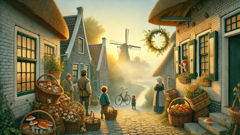
Bram awoke sore but unharmed, Luit perched at his windowsill like a solemn guardian. "You have honored our trust," the Kabouter elder said quietly. "Now, you must help your people remember."
Over the weeks that followed, Bram became a quiet champion for tradition. He taught children to care for hedgehogs and sparrows, showed farmers how to recognize signs of Kabouter blessings—a perfect mushroom ring, a glinting stone at the edge of a furrow—and encouraged everyone to leave small offerings in gratitude. His mother revived the ritual of cream by the hearth; his father spoke with pride of the old stories. Bit by bit, the pact between humans and Kabouters grew stronger, woven anew through acts of kindness and respect for the land.
Yet Bram never revealed all he had seen below. Some nights he returned to the clearing, where Luit would share tales of Kabouter history: how they once guided lost travelers through bogs by flickering lanterns, or turned away storms with songs carried on the wind. "Wisdom is not hoarded," Luit told him one evening as fireflies danced. "It is planted in the hearts of those willing to learn."
Under Bram’s gentle influence, Veldwoud flourished. Crops grew tall and golden, mills spun smoothly, and the woods teemed with game. The villagers grew more patient and generous; quarrels were settled quickly, and laughter came easier on long winter nights. In time, even those who’d mocked the old ways began to wonder if perhaps, beneath their very feet, friends watched over them still.
As Bram grew into manhood, he remained the quiet bridge between two worlds. He married and raised children of his own, teaching them to listen for whispers in the moss and respect every creature that called Veldwoud home. Sometimes, on moonlit nights, he would slip away to the woods and return with a knowing smile or a handful of perfect wild strawberries.
The legend of the Kabouter endured—etched into the rhythms of village life and the hearts of those who believed. And though most never glimpsed their tiny guardians, everyone came to understand that wisdom was not measured by size or strength but by the quiet courage to care for what could not always be seen.
Conclusion
The story of Bram and the Kabouter faded from living memory as new generations claimed Veldwoud’s fields and forests, yet its spirit lingered in every kind word, every humble offering, and every hand that worked with care. The village thrived not merely because of its luck or labor but because it had learned—through friendship, through trial, and through quiet wisdom—that true prosperity is rooted in respect for all that grows unseen. And though few ever glimpsed the gnomes in their red caps flitting through moonlit grass or heard their laughter in the hush between heartbeats, those who watched and listened closely sometimes found footprints no bigger than a hazelnut leading toward a mossy mound or a perfectly carved acorn cup left on a windowsill.
Bram grew old surrounded by family and friends who treasured his gentle stories and practical lessons. Even in his final years, he would pause on his morning walks at the edge of the Whispering Woods, eyes bright with secrets he never fully shared. Luit too faded into legend, but his wisdom lived on in every act of stewardship and wonder that blossomed in Veldwoud. As time unfurled its endless seasons, the pact between humans and Kabouters became part of the village’s very foundation—a quiet promise to honor the land and all its hidden wonders.
And so, in the heart of Holland where stories still grow like wildflowers, the legend of the Kabouter endures—reminding all who hear it that wisdom sometimes comes in small packages and that true guardians may walk just out of sight, waiting for those with open eyes and grateful hearts.

